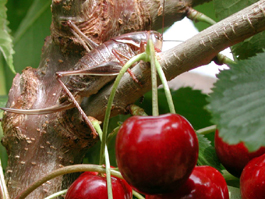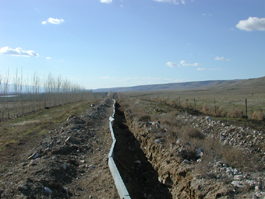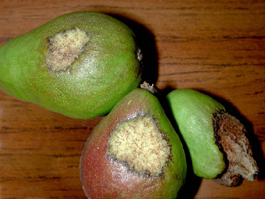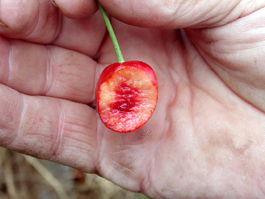by Michael W. Klaus, published online January 2008
Anabrus simplex (Haldeman) (Orthoptera: Tettigoniidae)

The Mormon cricket is actually not a true cricket, but rather a shield-backed katydid. The common name derives from this pest’s invasion of the crops of Mormon settlers in the Salt Lake area in the mid-1800s. The male of this species chirps (much like a cricket), hence the incorrect common name. Mormon crickets can occasionally be found in orchards adjacent to rangelands in the Pacific Northwest. They can strip trees of foliage but prefers to climb up into the trees to feed on the fruit.
Outbreaks usually occur when conditions are ideal for their growth and development, and can last from 5 to 20 years. Like grasshoppers, populations tend build up slowly so it is possible to predict areas at risk. The USDA, Animal and Plant Inspection Service monitors grasshopper and Mormon cricket activity and is a good resource for information on the latest outbreak risk areas.
Hosts
The Mormon cricket usually feeds on rangeland shrubs, forbs and grasses. However, migrating bands of nymphs or adults will feed on field and forage crops, fruit trees, vineyards, and grains. It can travel long distances in search of food. In 1996, the Mattawa area of the Columbia Basin in Washington State experienced high populations of Mormon crickets. Apple and cherry growers have suffered significant losses.
Life stages
Egg
The egg is white and elongate, 7 to 8 mm long.
Nymph
The nymph is similar to the adult but lacks wings.
Adult
The Mormon cricket is 1.5 to 2 inches (18 to 50 mm) long. It is gray green, purplish, brown to black. The hind tibiae are spiny. Its wings are not fully developed, and it cannot fly.
Life history
There is only one generation annually, although at high elevations it may take two years to develop. After Mormon crickets mate in early summer, females lay single eggs in the ground. Eggs hatch the following spring (March-May). Nymphs develop through seven instars and mature in early summer, about 60 days after hatching. Adults may continue to feed and lay eggs until late August depending on the elevation.
Most Mormon crickets live in the same general area throughout the year and are non-migratory. They breed in rangeland surrounding orchards and move into orchards in early summer when the range begins to dry up. The migratory phase of this species can travel one half to one mile a day up to 50 miles in a single season. They leave their breeding grounds and migrate in vast bands, occasionally encountering orchards or other cultivated areas, often devastating everything in their path.
Damage
Mormon crickets are voracious eaters and have sharp, powerful mandibles for chewing many kinds of plants. Their mandibles can easily chew into fruit. Feeding damage increases as the nymphs mature. Mormon crickets will strip trees of foliage and feed on the directly on the fruit. Damaged trees may be more prone to winter injury.
Monitoring
Look in the summer for feeding damage around or on the borders of the orchard. Record locations of adjacent rangeland areas where egg laying occurs so that hatching beds can be monitored in the following spring. Contact your local County Extension office, USDA Animal Plant Inspection Service or the Washington State Department of Agriculture if you are experiencing Mormon cricket problems in your area. They are sometimes able to coordinate cooperative efforts to control this pest.
Biological control
Mormon crickets have many natural enemies that play an important part in keeping them in check. Eggs are destroyed by some species of parasitic wasps and flies, and the larvae of many predatory insects.
Nymphs and adults are preyed upon by many animals including game birds, hawks, sea gulls, wasps, ground beetles and robber flies. Some parasitoids, such as hairworms, tachinids, and flesh flies attack nymphs and adults. Diseases can also keep populations down.
Management

Some of the chemicals commonly used in orchards will kill Mormon crickets. Insecticides are most effective against younger nymphs. The best strategy is to control Mormon crickets in the nymphal stages by spraying or baiting egg hatching beds in areas around the orchard. Some orchardists adjacent to rangelands have erected physical barriers and ditches to prevent the bands from entering the orchards.


